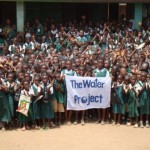This project was implemented by another partner, but is now monitored and maintained by The Water Project together with Mariatu's Hope.
A Sierra Leone team member commented, "This was such a great project. Every day the Chief was present at the site. He was such a great person to have around. There was such great interest by the community in this project. A goat was given to the Country Director at the dedication ceremony."
When the team arrived, community members were utilizing a mud hole located one kilometer away from the community to meet all of their water needs. Because of this, families were suffering from cholera, dysentery, typhoid, malaria and respiratory illnesses among other preventable water related illnesses. During the team's stay, community members assembled a water committee consisting of four men and four women who assisted the team with the water project whenever possible, provided food for the team, security over the water project during the night and housed the Sierra Leone team. The community’s use of a covered pit latrine also contributed to the spread of disease in the area and was not a practical sanitation solution for community families. The Sierra Leone team also constructed a composting toilet that is accessible by the entire community. Most community members earn a living by fishing, gardening, teaching, petty trading, making palm oil and producing coal. Before leaving the community, the team provided community member, Damalia Bangura, with a contact number in case their well were to fall into disrepair, become subject to vandalism or theft.
During the hygiene education, the Sierra Leone team addresses: Hand washing, how to properly transport and store water, disease transmission and prevention, how to maintain proper care of the pump, as well as signs and symptoms of dehydration and how to make Oral Rehydration Solution. All of these lessons are taught in a participatory method to help community members discover ways to improve their hygiene and sanitation choices, and implement community driven solutions. After the hygiene education, the community constructed a fence around the well site to keep livestock and wild animals away from their water source.
 WAsH for Schools
WAsH for Schools Rehabilitation Project
Rehabilitation Project













